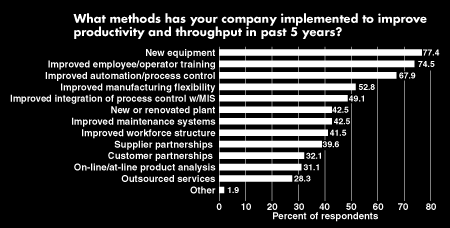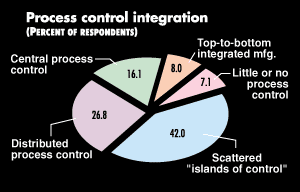Over the past several years,Food Engineering's annual manufacturing surveys have focused on manufacturing trends. Survey results were used to develop our annual "Manufacturing Trends" and "State of Manufacturing" reports. During that time, many of these trends gradually evolved into established manufacturing practices in various plants. So for the year 2000, we revised our annual manufacturing survey to reflect current "best practices" rather than future trends. We asked our Executive Advisory Panel to share with us the manufacturing improvements their plants and companies have achieved over the past five years, and how they achieved these improvements. The results follow.
Veteran panel Food Engineering's Executive Advisory Panel consists of more than 400 food-manufacturing professionals in top management, production management, engineering, quality control, packaging and purchasing across every segment of the industry. This year, 112 panel members contributed to the Best Practices Survey. Most are veterans: Nearly half (48 percent) have 20 or more years of experience in food manufacturing; 36 percent have 10 to 19 years experience. They also represent a cross-section of plant and company size: 34 percent are at locations employing fewer than 100 people; 27 percent are at locations employing 100-499 people; 26 percent at locations with employment exceeding 500. Seventeen percent work at dedicated plants (dedicated to long production runs of the same products with few changeovers); 40 percent at flexible plants (capable of producing several different products on the same lines with frequent changeovers); 36 percent at "hybrid" plants with both dedicated and flexible production lines. Not every respondent answered every question on our comprehensive survey. The percentages shown in the following graphs and tables therefore represent the percentage of respondents answering each question.
Percentages totaling more than 100 percent reflect multiple-choice questions allowing multiple answers.


Key factors: equipment, training & control
We then asked our panelists how they achieved these improvements in manufacturing efficiency. As shown on an adjoining graph, new equipment (77 percent), improved employee training (75 percent) and improved automation/process control (68 percent) led the methods employed to boost productivity and throughput. Forty-three percent enjoy new or renovated plants, indicating (along with the 77 percent reporting new equipment) increased capital spending.
Advanced automation & integration
More than half of our respondents (53 percent) cite improved manufacturing flexibility, while nearly half (49 percent) improved integration of their process controls with management information systems (MIS), and 43 percent upgraded their maintenance systems. Remarkable advances in automation and process control were confirmed by comparing responses to two questions withFood Engineering's 1999 "Manufacturing Trends" survey (FE, March 1999). When asked to rate their degree of process-control integration, only 42 percent of our panelists reported "scattered islands of control" as compared to 56 percent last year. Eight percent reported "top-to-bottom integrated manufacturing" -- up from just 3 percent last year -- and only 7 percent reported "little or no process control," down from 12 percent in 1999. One-third of our respondents (33 percent) have networked their systems up to the ERP (Enterprise Resource Planning) or corporate intranet level; 28 percent have established Internet or e-commerce links with customers, suppliers and outside databases. While 33 percent report networking up to the ERP or corporate intranet level, however, only 13 percent actually installed ERP software.
Improved flexibility
We asked our panelists to rate their degree of manufacturing flexibility according to product type, size and packaging. Results show substantial improvement as compared to last year's "Trends" survey: 55 percent report "great flexibility" by product type, up from 43 percent in 1999; 48 percent claim "great flexibility" by product size vs 44 percent last year; 44 percent rate their plants as having "great flexibility" in packaging, up from 39 percent last year. Only 28 percent report that packaging flexibility "needs improvement," down from 37 percent in 1999.
Maintenance focus
Good maintenance gets the most out of current assets, minimizing the need for capital spending. As shown, 71 percent of our panelists apply preventive maintenance, but 28 percent are stuck in a reactive-maintenance mode. Twenty percent practice predictive maintenance, recognized by many of our respondents as a key Best Practice. When asked what two or three Best Practices not currently implemented they wouldliketo see implemented in their plants, 25 percent of those answering cited "predictive maintenance." Forty percent of respondents report their plants equipped with computerized maintenance management systems (CMMS). Sixty-four percent of panelists' plants maintain a separate maintenance department, while 27 percent incorporate maintenance skills into their production teams. One-third (34 percent) report that their operators are trained to troubleshoot equipment and perform routine maintenance tasks, freeing maintenance technicians for heavier jobs.HACCP the norm
Recent outbreaks of foodborne disease have re-emphasized plant sanitation and food safety. In response, 79 percent of our panelists have improved employee training in these areas, and 75 percent have established HACCP programs. At the time our survey was conducted last autumn, 89 percent of respondent meat/poultry plants had implemented mandatory HACCP (very small meat plants were to comply by Jan. 25 this year). But more than two-thirds of respondent plants in every other industry segment (except beverage) had voluntarily implemented HACCP, and even 59 percent of beverage respondents reported a HACCP plan. Examples: 68 percent of reporting bakery plants, 79 percent of dairy plants and 100 percent of confectionery plants have HACCP plans in effect. Only 9 percent of our respondents, however, report that their plants have appointed HACCP coordinators (frequently a collateral duty for the QA manager) with no other responsibilities. Half of these are meat processors.
Teams & training
Skilled employees are hard to find in today's open job market, so most food companies have upgraded their training programs and apply a mix of training methods. As shown, supervised on-the-job training is still -- and probably always will be -- the most prevalent training method. But 57 percent of reporting companies include on-site classroom training, 53 percent utilize vendor training programs and 51 percent compensate tuition for job- related outside courses.Fifty-two percent cross-train employees in various skills, and 18 percent have established formal skill-block training and certification programs. Typically, workers can earn more pay as they master each skill and progress upward through successive skill blocks, and 23 percent of our respondents have established pay-for-skills programs. Twenty percent of panelist companies share corporate operating and financial data with their employees. Only 7 percent have no formal training programs. More than half of our respondents (56 percent) report that their plants have established either self-managing or shared-leadership work teams on the plant floor. Of those which have established self-managing teams, 70 percent say the concept works.
Successes & wish lists
To conclude our survey, we asked our respondents: "Which two or three 'best practices' have been most effective in improving manufacturing efficiency at your plant or company?" By far, most responses relate to "people issues" such as improved training, management and workforce structures. "Plant management communicating with line workers," says a dairy plant manager. "Self-directed work teams, operator-based maintenance and multiskill technicians," adds a brewery team manager. A canning plant engineer cites "organized cost-reduction teams." Another plant engineer credits "cross-platform engineering teams" with "more involvement and 'ownership' of design changes." An engineering manager at a major Midwest-based multiproducts manufacturer sums it up in a single word: "Empowerment!" Improved automation ranks second among responses. "Automation and SCADA systems have provided tools to diagnose and solve operating problems more quickly," says a division manager an Eastern-based multiproducts company. "SPC information available to operators through a SCADA system," adds a controls engineer. "SPC (for) control" and "MRP (for) information," cites a plant manager. Many responses relate to improved engineering, maintenance and equipment. "Improved changeover time streamlined the process, and reduced the number of employees needed for changeover so they are free to work in other areas," said a Midwestern plant manager. "Preventive maintenance," said the president of a frozen-food company. "Packaging efficiency modification increased efficiency" while" problem-solving/implementation teams increased results," adds a QA manager for a snack-food producer. "Operator maintenance" provides "quicker fixes," while "HACCP reduced scrap and rework," observes the QA director at grain milling company. "Our work is very labor-intensive," so "work-station design and proper tool selection have given us our greatest improvements," writes a poultry plant manager. We then asked our panelists: "Which two or three 'best practices' not currently implemented would youliketo see at your plant or company?" As noted earlier, 25 percent of those answering this question responded: "Predictive maintenance!" A process engineer at a Texas meat plant wants a "pay-for-skills" system where "responsibility goes to the workers." Many want improved automation. "On-line SPC," says a QA manager for a snack-food producer. "Automated batch control," adds a process development engineer for a major ingredient manufacturer. Several want workforce improvements such as pay-for-skills systems, self-directed work teams, formal training curricula, employee bonus programs and "accountability for actions." A dairy plant manager hopes for improved morale. "I would like to see management appreciate our line workers (who) are doing a good job, rather than being suspicious of them because they are union members," he writes. "Sometimes, this creates an unhealthy work environment."Food Engineering launches the new millennium with the food industry's first study of Best Manufacturing Practices. Benchmark your plant against survey results! What changes has your company made in workforce design? (Percent respondents) :
Organized continuous-improvement or cost-reduction teams 42.2No change in traditional management/labor system 39.4
Organized self-directed work teams on the plant floor 30.3
Reduced engineering/operations staff through restructuring or downsizing 29.4
Organized management-directed or shared-leadership work teams on the plant floor 25.7
Organized multidisciplinary product-development teams 20.2
Hiring fewer workers at higher skill levels 9.2
Partnership with unions in plant management 5.5
Other 0.9
Best Manufacturing Practices Survey
(Respondents by industry segment)
Beverages 19.6Flavors/ingredients 18.8
Bakery 17.0
Meat/poultry 16.1
Cereals/grain products 14.3
Dairy 12.5
Canned fruit/veg/entrees 10.7
Fats & oils 9.8
Frozen fruit/veg/entrees 8.9
Confectionery products 6.3
Other 27.7
(Responses total more than 100 percent because some respondents are multisegment manufacturers.)
